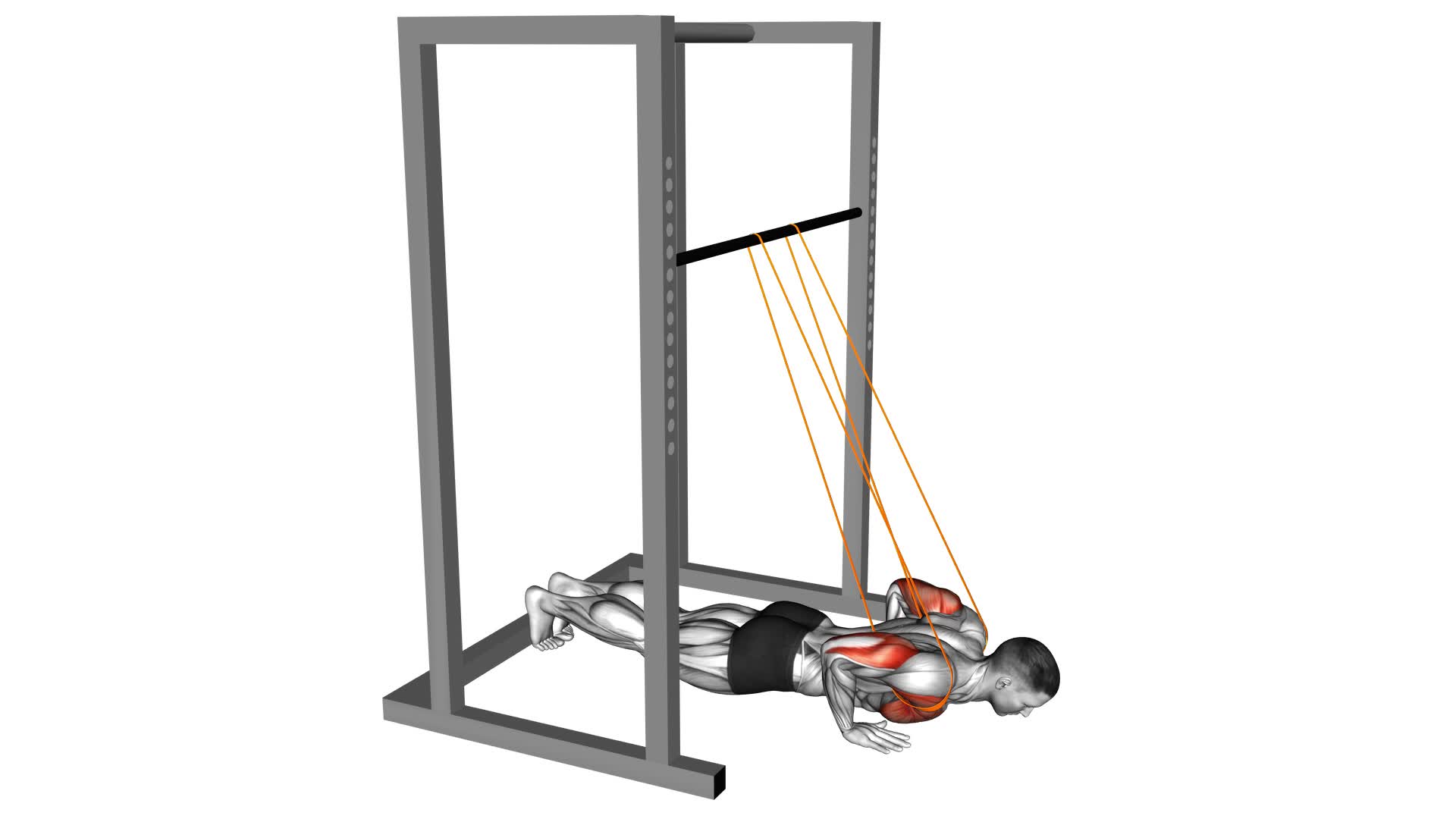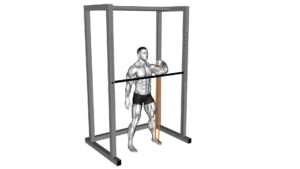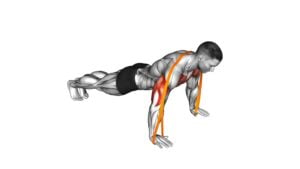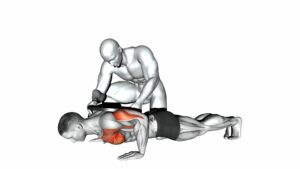Resistance Band Assisted Push-up (male) – Video Exercise Guide & Tips

Looking to level up your push-up game? Try the resistance band assisted push-up!
Watch This Exercise Video
This exercise is a great way to build strength and target your chest, shoulders, and triceps.
In this video exercise guide, we'll show you the proper technique and form, along with variations and progressions to challenge yourself.
Get ready to maximize your results and take your push-ups to the next level with the resistance band assisted push-up.
Let's dive in!
Key Takeaways
- Resistance band assisted push-ups increase intensity and effectiveness of upper body strength training
- Resistance bands offer variable resistance throughout the entire range of motion, improving stability and balance
- Choosing the right resistance band involves considering strength level, body type, and exercise versatility
- Proper technique, form, and progressions are important for maximizing the benefits of resistance band assisted push-ups
Benefits of Resistance Band Assisted Push-ups
By incorporating resistance band assisted push-ups into your workout routine, you can significantly increase the intensity and effectiveness of your upper body strength training. Resistance bands offer numerous benefits that can enhance your push-up workout.
Firstly, they provide variable resistance throughout the entire range of motion, making the exercise more challenging and engaging your muscles more effectively. This can lead to greater muscle activation and growth.
Additionally, resistance bands help improve stability and balance, as you need to control the tension and maintain proper form throughout the movement. This can result in stronger and more stable shoulders, chest, and core muscles.
Another advantage of using resistance bands is that they allow for a greater range of motion compared to traditional push-ups. This increased range of motion can lead to improved flexibility and joint mobility.
To ensure proper form when performing resistance band assisted push-ups, make sure to maintain a straight line from your head to your heels, engage your core, and keep your elbows close to your body.
Choosing the Right Resistance Band
When choosing the right resistance band for your workouts, there are a few key points to consider.
First, think about the strength level of the band and how it aligns with your current fitness level.
Additionally, take into account your body type and any specific areas you want to target.
Lastly, consider the versatility of the bands and how they can be used for various exercises to maximize your training.
Band Strength Levels
To choose the right resistance band for the assisted push-up, assess your current strength level. Band strength levels vary and it's important to find the one that suits your abilities. Consider your body type as well when selecting the resistance band.
If you're a beginner or have lower strength, start with a lighter band. As you progress and become stronger, you can move on to a band with higher resistance. It's important to challenge yourself but not to the point where your form suffers.
On the other hand, if you're already experienced and have a higher strength level, opt for a band with greater resistance. Remember to choose a band that allows you to perform the exercise with proper technique and control.
Body Type Considerations
Consider your body type when selecting the right resistance band for the assisted push-up. This will ensure that the band complements your abilities and allows you to maintain proper form and control.
Body type considerations are important because different individuals have varying strengths, flexibility, and range of motion. If you're a beginner or have limited upper body strength, you may benefit from a lighter resistance band. This will allow you to gradually build your strength and avoid unnecessary strain.
On the other hand, if you're more advanced or have a larger build, a stronger resistance band may be necessary. This will challenge your muscles effectively and help you continue to progress.
Modifying exercises based on your body type can help you progress safely and effectively. It's always recommended to consult with a fitness professional to determine the appropriate resistance band for your specific needs.
Versatility of Bands?
To choose the right resistance band for the assisted push-up, consider the versatility of bands in terms of their varying levels of resistance. Resistance bands are a great tool for adding resistance to exercises, such as push-ups, and can be used to target different muscle groups.
The benefits of using bands for upper body strength exercises are numerous. They allow for a full range of motion, engage stabilizing muscles, and can be easily adjusted to match your fitness level. Bands also provide a safer alternative to heavy weights, reducing the risk of injury.
Whether you're a beginner or an advanced athlete, there's a resistance band that suits your needs. Experiment with different bands to find the right level of resistance that challenges you and helps you achieve your fitness goals.
Setting Up for the Exercise
Grab a resistance band and attach it securely to a sturdy anchor point at chest height. This is the first step in setting up for the resistance band assisted push-up exercise. Ensure that the anchor point is stable and can withstand the tension from the band. Common mistakes include using a weak or unstable anchor point, which can lead to accidents or injuries during the exercise.
Next, position yourself facing away from the anchor point. Place your hands on the floor slightly wider than shoulder-width apart. Engage your core and extend your legs behind you into a plank position. Keep your body in a straight line from head to heels.
Now, loop the resistance band around your upper back, just below your shoulder blades. Hold onto the ends of the band with your hands, maintaining tension in the band throughout the exercise.
To execute the push-up, lower your chest towards the floor, bending your elbows while keeping your body in a straight line. Push back up to the starting position, fully extending your arms.
Remember to maintain proper form and control throughout the exercise. By setting up correctly and avoiding common mistakes, you can maximize the effectiveness of the resistance band assisted push-up.
Proper Technique and Form
You should consistently focus on maintaining proper technique and form while performing the resistance band assisted push-up exercise. By doing so, you can maximize the benefits of this exercise and avoid common mistakes that may lead to injury or ineffective results.
Proper technique ensures that you engage the targeted muscles effectively and efficiently. It allows you to maintain proper alignment of your body, preventing strain on your joints and minimizing the risk of injury. By keeping your core engaged and your body in a straight line from head to toe, you can effectively work your chest, shoulders, triceps, and core muscles.
To maintain proper form, avoid common mistakes such as sagging your hips or allowing your lower back to arch. This can put unnecessary stress on your lower back and diminish the effectiveness of the exercise. Additionally, make sure to lower your body in a controlled manner, maintaining a slow and controlled tempo throughout the movement.
With proper technique and form, you can progress to more challenging variations of the resistance band assisted push-up exercise. These variations will be discussed in the next section, allowing you to continue challenging your muscles and achieving your fitness goals.
Variations and Progressions
Explore different variations and progressions to challenge your muscles and enhance the effectiveness of the resistance band assisted push-up exercise. By incorporating these variations and modifications, you can target specific muscle groups and continue to make progress in your fitness journey.
Here are three ways you can vary the resistance band assisted push-up:
- Wide Grip Push-up: Place your hands wider than shoulder-width apart on the resistance band and perform the push-up. This variation targets your chest muscles and outer shoulders more intensely.
- Close Grip Push-up: Bring your hands closer together, forming a diamond shape with your index fingers and thumbs. This variation shifts the focus to your triceps and inner chest muscles.
- Single Arm Resistance Band Assisted Push-up: Loop the resistance band around one hand and perform the push-up with the other hand. This modification increases the demand on your core and stabilizer muscles, as well as providing a unilateral challenge.
Remember to start with the variation that best suits your current strength level and gradually progress to more challenging options as you become more comfortable. Experimenting with these variations will keep your workouts interesting and help you achieve your fitness goals.
Tips for Maximizing Results
To maximize your results with resistance band assisted push-ups, it's important to focus on proper form techniques. This means maintaining a straight line from your head to your heels and engaging your core throughout the movement.
Additionally, progressive resistance training is crucial for continued improvement, so gradually increase the resistance of the band as you get stronger.
Lastly, don't forget to prioritize rest and recovery, as this allows your muscles to repair and grow stronger.
Proper Form Techniques
Maximize your results by focusing on proper form techniques during the resistance band assisted push-up exercise. To ensure you get the most out of this exercise, keep the following tips in mind:
- Resistance band modifications: Experiment with different band tensions to find the one that challenges you without compromising your form. Adjust the length of the band to increase or decrease resistance as needed.
- Maintain a neutral spine: Avoid arching or rounding your back during the movement. Engage your core muscles to keep your spine in a straight line from head to toe.
- Avoid common mistakes: Don't let your elbows flare out to the sides; instead, keep them close to your body. Lower yourself with control and avoid sagging in the hips or sinking in the shoulders.
Progressive Resistance Training
To maximize your results, incorporate progressive resistance training techniques into your resistance band assisted push-up routine.
Progressive resistance training involves gradually increasing the resistance or difficulty level of your exercises over time. This can be done by using a stronger resistance band, increasing the number of repetitions, or adding additional resistance like a weighted vest. By continuously challenging your muscles, you stimulate further growth and strength gains.
Resistance band exercises are ideal for progressive resistance training because they offer variable resistance throughout the entire range of motion. To make the most of this training method, start with a resistance band that allows you to perform 8-12 reps with good form, and then gradually increase the resistance as you get stronger.
Remember to always listen to your body and progress at a pace that feels challenging but manageable.
Rest and Recovery
Take advantage of rest and recovery periods to optimize your results and enhance muscle growth. Rest and recovery are essential components of any effective training program, including progressive resistance training. Here are three tips to maximize your rest and recovery:
- Prioritize sleep: Aim for 7-9 hours of quality sleep per night to allow your body to repair and regenerate. Lack of sleep can hinder muscle recovery and growth.
- Active recovery: Engage in low-intensity activities like walking, stretching, or yoga on your rest days. This promotes blood flow, reduces muscle soreness, and aids in recovery.
- Proper nutrition: Fuel your body with a balanced diet rich in protein, carbohydrates, and healthy fats. Adequate nutrition supports muscle repair and growth, and helps replenish energy stores.
Frequently Asked Questions
How Long Should I Hold the Resistance Band During a Resistance Band Assisted Push-Up?
To get the most out of your resistance band assisted push-ups, you'll want to hold the resistance band for about 1-2 seconds at the bottom of each rep. This will help maintain tension and engage your muscles effectively.
However, the holding duration can vary depending on your fitness level and goals. Feel free to experiment with different holding durations to find what works best for you.
Remember to always listen to your body and adjust as needed.
Can Resistance Band Assisted Push-Ups Help With Building Muscle Mass?
Resistance band exercises, like resistance band assisted push-ups, can indeed help with building muscle mass. By adding resistance to your push-up, the resistance band forces your muscles to work harder, leading to greater muscle activation and growth.
Resistance training, in general, offers numerous benefits such as increased strength, improved muscle tone, and enhanced overall fitness. So, incorporating resistance band exercises into your workout routine can be an effective way to achieve your muscle-building goals.
Are Resistance Band Assisted Push-Ups Suitable for Beginners?
Resistance band assisted push-ups can be a suitable option for beginners. They provide support and help build strength gradually. By incorporating resistance band modifications, you can adjust the intensity according to your fitness level.
Additionally, there are alternative push-up variations that can be performed with resistance bands, allowing you to target different muscle groups and challenge yourself further.
Starting with these modifications can help you progress and eventually perform regular push-ups with ease.
Can Resistance Band Assisted Push-Ups Be Done Without a Partner?
Resistance band assisted push-ups can definitely be done without a partner. They're a great alternative to regular push-ups, providing added resistance and helping to build strength. Using resistance bands allows you to adjust the level of difficulty based on your fitness level.
Plus, the benefits of resistance band assisted push-ups include targeting different muscle groups, improving stability, and increasing overall upper body strength.
How Often Should I Incorporate Resistance Band Assisted Push-Ups Into My Workout Routine?
To effectively incorporate resistance band assisted push-ups into your workout routine, it's important to consider a few factors.
First, aim to incorporate other variations of push-ups to avoid overworking specific muscle groups.
Second, the benefits of resistance bands include increased resistance and improved stability.
With that in mind, try incorporating resistance band assisted push-ups two to three times a week, gradually increasing the number of sets and reps as your strength and endurance improve.
Conclusion
The resistance band assisted push-up is a highly effective exercise for building upper body strength. By using a resistance band, you can modify the intensity of the exercise to suit your fitness level.
It's important to choose the right band and set it up correctly for optimal results. Remember to maintain proper form and technique throughout the exercise.
With variations and progressions, you can gradually increase the difficulty and challenge your muscles even more. Follow these tips to maximize your results and achieve your fitness goals.

Author
Years ago, the spark of my life’s passion ignited in my mind the moment I stepped into the local gym for the first time. The inaugural bead of perspiration, the initial endeavor, the very first surge of endorphins, and a sense of pride that washed over me post-workout marked the beginning of my deep-seated interest in strength sports, fitness, and sports nutrition. This very curiosity blossomed rapidly into a profound fascination, propelling me to earn a Master’s degree in Physical Education from the Academy of Physical Education in Krakow, followed by a Sports Manager diploma from the Jagiellonian University. My journey of growth led me to gain more specialized qualifications, such as being a certified personal trainer with a focus on sports dietetics, a lifeguard, and an instructor for wellness and corrective gymnastics. Theoretical knowledge paired seamlessly with practical experience, reinforcing my belief that the transformation of individuals under my guidance was also a reflection of my personal growth. This belief holds true even today. Each day, I strive to push the boundaries and explore new realms. These realms gently elevate me to greater heights. The unique combination of passion for my field and the continuous quest for growth fuels my drive to break new ground.



